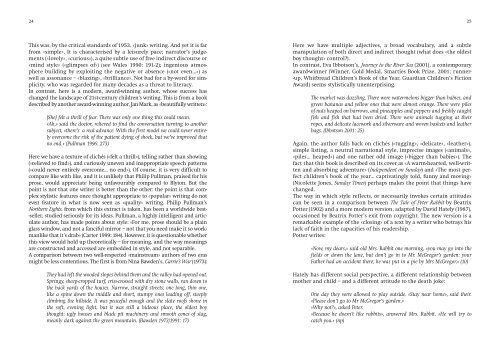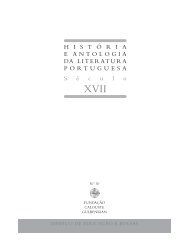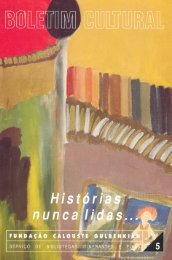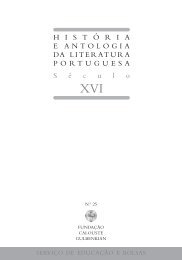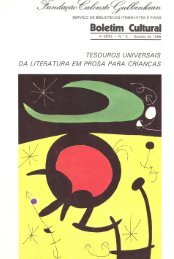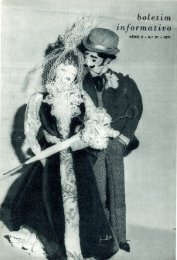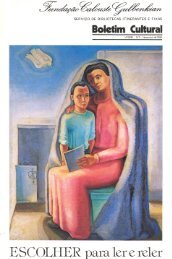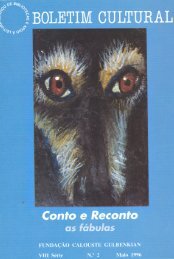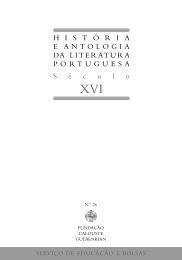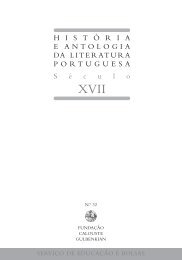Formar Leitores para Ler o Mundo - Leitura Gulbenkian - Fundação ...
Formar Leitores para Ler o Mundo - Leitura Gulbenkian - Fundação ...
Formar Leitores para Ler o Mundo - Leitura Gulbenkian - Fundação ...
You also want an ePaper? Increase the reach of your titles
YUMPU automatically turns print PDFs into web optimized ePapers that Google loves.
24<br />
This was, by the critical standards of 1953, «junk» writing. And yet it is far<br />
from «simple». It is characterised by a leisurely pace; narrator’s judgements<br />
(«lovely», «curious»), a quite subtle use of free indirect discourse or<br />
«mind style» («glimpses of») (see Wales 1990: 191-2); ingenious atmosphere<br />
building by exploiting the negative or absence («not even...») as<br />
well as assonance – «blazing», «brilliance». Not bad for a by-word for simplicity,<br />
who was regarded for many decades as a threat to literacy.<br />
In contrast, here is a modern, award-winning author, whose success has<br />
changed the landscape of 21st-century children’s writing. This is from a book<br />
described by another award-winning author, Jan Mark, as «beautifully written»:<br />
[She] felt a thrill of fear. There was only one thing this could mean.<br />
«Ah,» said the doctor, relieved to find the conversation turning to another<br />
subject, «there’s a real advance. With the first model we could never entirely<br />
overcome the risk of the patient dying of shock, but we’ve improved that<br />
no end.» (Pullman 1996: 273)<br />
Here we have a texture of clichés («felt a thrill»), telling rather than showing<br />
(«relieved to find»), and curiously uneven and inappropriate speech patterns<br />
(«could never entirely overcome... no end»). Of course, it is very difficult to<br />
compare like with like, and it is unlikely that Philip Pullman, praised for his<br />
prose, would appreciate being unfavourably compared to Blyton. But the<br />
point is not that one writer is better than the other: the point is that complex<br />
stylistic features once thought appropriate to «popular» writing do not<br />
even feature in what is now seen as «quality» writing. Philip Pullman’s<br />
Northern Lights, from which this extract is taken, has been a worldwide best-<br />
-seller, studied seriously for its ideas. Pullman, a highly intelligent and articulate<br />
author, has made points about style: «For me, prose should be a plain<br />
glass window, and not a fanciful mirror – not that you need make it so workmanlike<br />
that it’s drab» (Carter 1999: 184). However, it is questionable whether<br />
this view would hold up theoretically – for meaning, and the way meanings<br />
are constructed and accessed are embedded in style, and not se<strong>para</strong>ble.<br />
A comparison between two well-respected «mainstream» authors of two eras<br />
might be less contentious. The first is from Nina Bawden’s, Carrie’s War (1973):<br />
They had left the wooded slopes behind them and the valley had opened out.<br />
Springy, sheep-cropped turf, criss-crossed with dry stone walls, ran down to<br />
the back yards of the houses. Narrow, straight streets; one long, thin one,<br />
like a spine down the middle and short, stumpy ones leading off, steeply<br />
climbing the hillside. It was peaceful enough and the slate roofs shone in<br />
the soft, evening light, but it was still a hideous place, the oldest boy<br />
thought: ugly houses and black pit machinery and smooth cones of slag,<br />
meanly dark against the green mountain. (Bawden 1973/1991: 17)<br />
Here we have multiple adjectives, a broad vocabulary, and a subtle<br />
manipulation of both direct and indirect thought (what does «the oldest<br />
boy thought» control?).<br />
In contrast, Eva Ibbotson’s, Journey to the River Sea (2001), a contemporary<br />
award-winner (Winner, Gold Medal, Smarties Book Prize, 2001; runner-<br />
-up, Whitbread Children’s Book of the Year, Guardian Children’s Fiction<br />
Award) seems stylistically unenterprising.<br />
The market was dazzling. There were watermelons bigger than babies, and<br />
green bananas and yellow ones that were almost orange. There were piles<br />
of nuts heaped on barrows, and pineapples and peppers and freshly caught<br />
fish and fish that had been dried. There were animals tugging at their<br />
ropes, and delicate lacework and silverware and woven baskets and leather<br />
bags. (Ibbotson 2001: 25)<br />
Again, the author falls back on clichés («tugging», «delicate», «leather»),<br />
simple listing, a neutral narrational style, imprecise images («animals»,<br />
«piles... heaped») and one rather odd image («bigger than babies»). The<br />
fact that this book is described on its cover as «A warm-hearted, well-written<br />
and absorbing adventure» (Independent on Sunday) and «The most perfect<br />
children’s book of the year... captivatingly told, funny and moving»<br />
(Nicolette Jones, Sunday Times) perhaps makes the point that things have<br />
changed.<br />
The way in which style reflects, or necessarily invokes certain attitudes<br />
can be seen in a comparison between The Tale of Peter Rabbit by Beatrix<br />
Potter (1902) and a more modern version, adapted by David Hately (1987),<br />
occasioned by Beatrix Potter’s exit from copyright. The new version is a<br />
remarkable example of the «closing» of a text by a writer who betrays his<br />
lack of faith in the capacities of his readership.<br />
Potter writes:<br />
«Now, my dears,» said old Mrs. Rabbit one morning, «you may go into the<br />
fields or down the lane, but don’t go in to Mr. McGregor’s garden: your<br />
Father had an accident there; he was put in a pie by Mrs McGregor.» (10)<br />
Hately has different social perspective, a different relationship between<br />
mother and child – and a different attitude to the death joke:<br />
One day they were allowed to play outside. «Stay near home», said their.<br />
«Please don’t go to Mr McGregor’s garden.»<br />
«Why not?», asked Peter.<br />
«Because he doesn’t like rabbits», answered Mrs. Rabbit. «He will try to<br />
catch you.» (np)<br />
25


